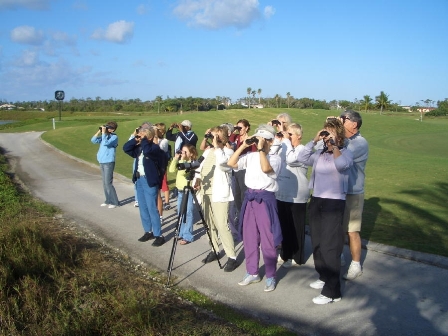
Grand Bahama birders in their own "backyard" birding not only for pleasure, excercise and cameraderie. They are identifying birds, studying their behaviour, feeding habits, migration etc. and contribute to science by participating in bird counts and assisting visiting researchers and ornithologists in the field.
|
Do you ne’er think what wondrous beings these?
Do you ne’er think who made them, and who taught
The dialect they speak, where melodies
Alone are the interpreters of thought?
Whose household words are songs in many keys?
Sweeter than instrument of man e’er caught!
H. W. Longfellow – American Poet
Birds have been celebrated in poetry and in song throughout the centuries. Of all the creatures in the world birds share our perceptual space the most. They sing and call at frequencies that most of us can hear and they display colors and behaviors that we can easily see and enjoy. Thus, we are able to identify with birds and share in their lives to a greater extent than we can with most of the other creatures with which we share our planet.
At the same time, birds are exotic. They fly! They fly fast, they fly high, they hover, they fly backwards and they fly thousands of miles in a few weeks, disappearing in the fall and reappearing on our doorstep the next spring!
Bird-watching is literally about watching birds, but it can be practiced in countless different ways. It can be scientific or pure pleasure. It can be competitive or for physical exercise. It can be done in one’s own backyard or in a distant country’s wilderness. It can involve simply identifying different species or studying bird songs, behavior, feeding habits, migration, nesting etc. It may involve observing the interaction between birds and their environment – plants, insects, weather or humans.
All these various approaches have one thing in common: they begin with bird identification. It is the challenge and the process of identification that is the primary focus of a birding class or course. In a classroom setting, the proper use of binoculars is explained, a field guide becomes a trusty companion for identification rather than an overwhelming source of information and the inevitable checklist turns into a cherished life-long document! Each lesson is followed by the highly anticipated fieldtrip where eyes and ears of novice birders are sensitized to the wonders of nature.
Interested? Be careful! You may just be taking up a rich, lifelong pursuit unlike any other!
PHOTO 1(click to enlarge):
One of the most colorful birds in the Bahamas is the male Stripe-headed Tanager. Birders travel from afar to observe this species and to add it to their life list. The bird does not occur in the U.S., Canada or Europe!
Photo 2:
This Black-necked Stilt is a rare visitor to Grand Bahama Island but enjoys foraging along the edges of ponds on the Reef Golf Course.
